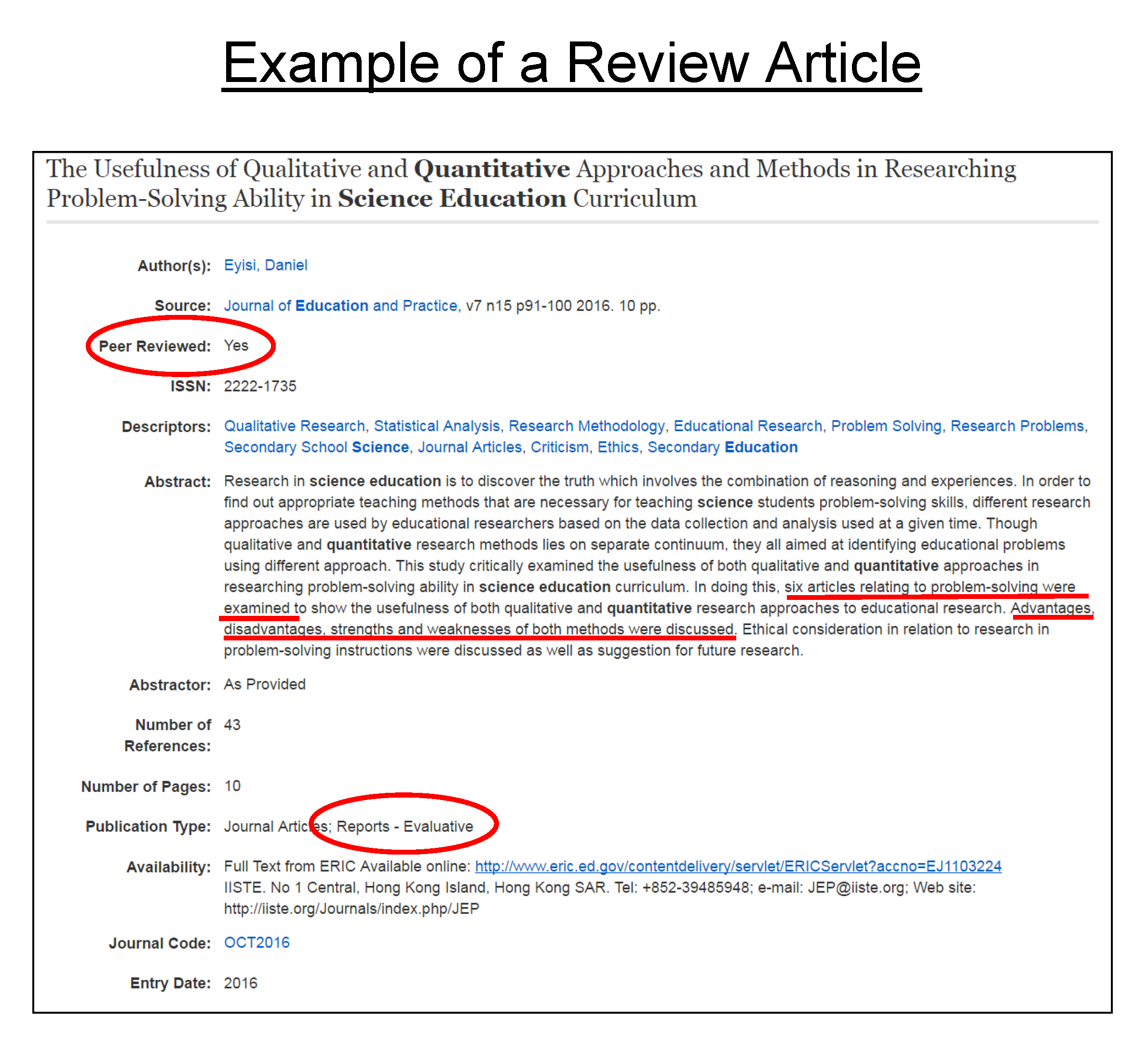Criteria for Evaluating Articles
Articles can be evaluated by many different criteria.
Regular Research & Evaluation Criteria: Peer Review & Research Articles
Professors will often ask students to look for peer reviewed research articles. You can limit your search results in many databases, including ERIC, to peer reviewed articles and research articles. (What is Peer Review?)
Qualitative versus Quantitative Evaluation Criteria
There is no easy way to limit the search results to qualitative or quantitative research. Sometimes the abstract will give enough information to determine the type of research. Other times you will need to open the PDF of the article. The methodology should provide a description of the research methods, from this you can determine if the article is qualitative or quantitative. (Learn more below.)
Primary versus Secondary Evaluation Criteria
Often, when your professor asks for research articles, they want you to find primary research articles. Primary research article report on original research. In other words, the authors are reporting on the research they conducted. Secondary articles evaluate, critique, report on, or summarize other researchers' research. A literature review is a secondary article. Literature reviews are very informative and may cite primary articles, but they are secondary. (Learn more below.)
Qualitative versus Quantitative
Qualitative Research
Qualitative research methods are focus groups, interviews, content analysis, etc. In short, the data collected will mostly be words.
Quantitative Research
Quantitative research methods focus on collection numerical data. In short, the data collected will be numbers, such as sampling and statistics.
Mixed Methods
Mixed methods articles include a mix of qualitative and quantitative methods.
On this page are examples of abstracts of different types of research articles. We have highlighted the information you are looking for when you are evaluating and article.
Use the Results Page
Use the information on the results page to pre-evaluate the article:
Questions to Ask Yourself
-
What is the citation information?
-
Is it peer reviewed?
-
Is it a research article? Is it primary or secondary?
-
Is the research qualitative or quantitative?
-
What is the article about?
Once you decide the article could be pertinent, open the full-text and read it. Remember, if the library does not have the full-text you can request the article through ILL-Odum Express.
Primary Research Article
What is a primary research article?
A primary research article reports on the original research and findings of the authors. Primary research articles have the following sections:
Title
A brief description of the scholarly article in the form of a title. It should at least give you a general idea about what the article is about.
Abstract
A preview of the scholarly article. It should address the purpose, method and results that will be found in the article.
Introduction
Describes the purpose of the scholarly article. May provide an overview of the field and previous research in the form of a Literature Review.
Methods
Describes how the research and what type of research was conducted.
Results
Presents the outcome of the research.
Discussion
Analyzes the results to determine what potential impact it could have on the scholarly field or community.
Conclusion
Reiterates points made throughout the article, including potential for further research.
References
Works cited throughout the scholarly article by the author. The list should contain all the relevant information needed for you to find the resource for yourself.
Examples of Review, Quantitative and Qualitative Articles
This is an example of a qualitative article abstract.
Besides containing the Descriptor, Qualitative Research, it also contains a descriptor for Semi-Structured Interviews, which fits with qualitative data collection. Further evidence that supports its qualitative nature are the phrases content analysis and descriptive analysis.

This is an example of a review article. The author selected existing research articles on the topic and examined them, critiquing the existing literature.
Click the arrow to move to the next slide.

This is an example of a quantitative article abstract.
Besides containing the word, quantitative, this abstract references the article's methodology and refers to a statistical analysis and cluster analysis, which are quantitative features.
Permanent link to article record
Click the arrow to continue to the qualitative article.
